Wrike and monday.com are industry-leading project management software known for their versatility, comprehensive features, and easy integrations. Both providers are priced similarly and support a wide range of workflow types. After comparing Wrike vs monday.com, we found that monday.com stands out for its usability and project data visualization, while Wrike focuses on workflow automation.
- Wrike: Best for cross-functional project workflow
- monday.com: Best for customization and user-friendly task management
For multiple teams looking for a centralized tool for task management, time tracking, and collaboration, we recommend:
- ClickUp: Best all-in-one productivity solution
Wrike vs monday.com at a Glance
$10.00 per user | $10 per user | |
Free Trial | 14 days | 14 days |
Project Views
| ✓ | ✓ |
Storage Space | 2GB to 15GB | 500MB to 1,000GB |
Project Management
| ✓ | ✓ |
Workflow Automation | ||
Third-party Integrations | 400+ apps | 200+ apps |
Offline Mode for Mobile App | ✓ | ✓ |
| ✓ | ✓ |
For More Information |
Before delving into our Wrike vs monday.com match-up, get in-depth information in our monday.com review and learn more about its pricing, features, and use cases.
Best Alternatives
The competition in the project management software industry is stiff with all the emerging providers in the market. Different project teams might have specific needs that Wrike and monday.com cannot support, such as built-in team chat, agile-specific tools, and extensive reporting capabilities. Check out our top picks below and see what sets them apart:
- ClickUp: This all-in-one productivity tool comes with complete tools for planning, tracking, and collaborating on any project. It has over 15 project views to support different work styles and robust customization capabilities for fields, dashboards, and statuses. With its extensive reporting features, ClickUp is best for teams needing a high-level overview of their work to track the progress of specific projects.
- Trello: This provider is a Kanban-style project management software that uses boards, lists, and cards for tracking tasks and managing project workflow. While it is not as feature-rich as other competitors, Trello offers the right amount of tools for small-scale task management. Monthly plans start at $6 per user. Core features include views, automation, integrations, and templates.
- Asana: Asana is a solid choice for managing multiple, complex projects. It supports any workflow type like project management, agile management, and strategic planning. It has a monthly starting fee of $13.49 per user and is packed with features for driving team efficiency, automating processes, and tracking project status. From custom fields to dependencies, it has all the tools you need to handle agile projects and scrum sprints.
Best for Pricing: monday.com
All plans apply to a minimum team size of three users and are based on a monthly per-user basis. Save 18% by paying yearly. |
Pricing displayed is cost per month and billed on an annual per user basis. |
Both providers offer a free plan for small teams who can get by with basic project management. However, if we’re looking at the cost and capabilities of their paid plans, monday.com is more cost-effective as it covers more benefits within the same price range.
monday.com’s paid plans let you add as many users as you like, unlike Wrike, which restricts the number of users. It’s also worth noting that monday.com has a larger storage space, volume discounts, 24/7 support, and unlimited access to third-party apps.
Wrike tends to add up fast for advanced plans with add-ons. For instance, there is a noticeable $15 price jump between the Team and Business plans, making Wrike less budget-friendly. Plus, Wrike requires users to pay extra for full access to third-party integrations. But if you’re willing to settle for a free plan, Wrike has better offerings with bigger cloud storage, unlimited user capacity, and work intelligence tools.
Best for Task Management: monday.com
|
|
Wrike and monday.com both have extensive task management with subtasks, deadlines, assignees, and attachments. However, we highly favor monday.com for this category as it’s less complex to use for task management compared to Wrike.
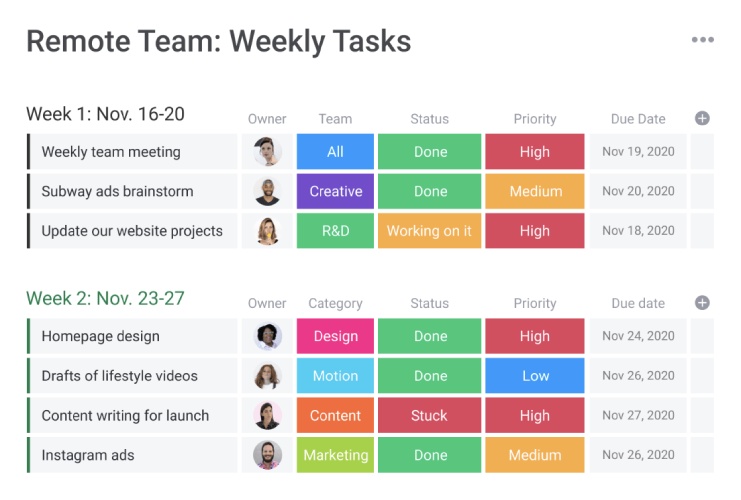
monday.com utilizes colors to differentiate project items like tasks, teams, and status. (Source: monday.com)
With monday.com, users get full transparency for tracking tasks with color-coded columns, threaded comments, and team mentions. Optimize your entire workflow with task boards and push projects forward faster with over 200 customizable templates. You can organize your tasks on boards, which are made up of tasks and subtasks, and then use columns to categorize based on assignees, date, priority, timeline, and status.
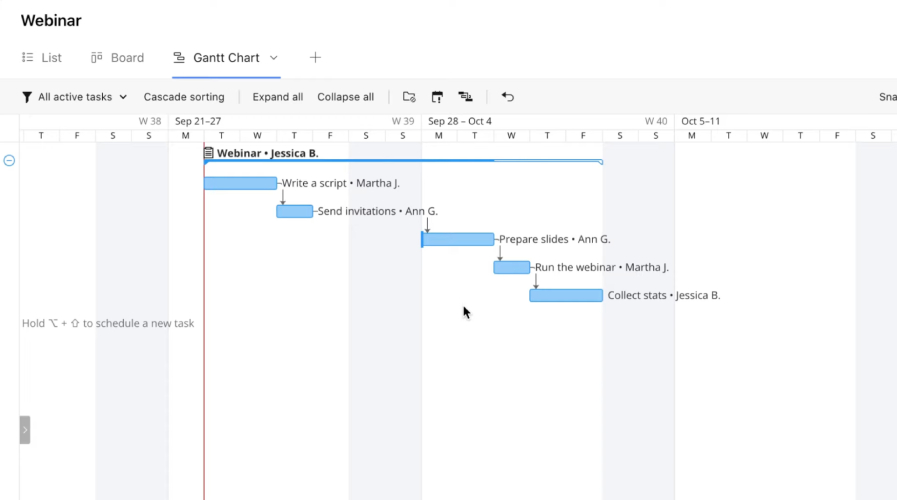
Wrike lets you set the duration of each task using the Gantt chart. (Source: Wrike)
Wrike focuses primarily on large-scale project management, with its powerful features like risk monitoring, process automation, and agile work management. Still, Wrike does well in the task management area but slightly lacks flexibility. For instance, you need to set up a workspace first, which consists of spaces, folders, and projects before you can start creating tasks.
Best for Team Collaboration: Wrike
|
|
Wrike takes a more in-depth approach when it comes to supporting team collaboration on projects. The cross-tagging feature works across tasks, subtasks, and folders to enable separate teams to easily track and monitor an item in the context of their respective workflows. Build custom groups for selected users to share data, tasks, and folders and create an approval workflow with internal and guest approvers to gain full visibility on approval decisions.
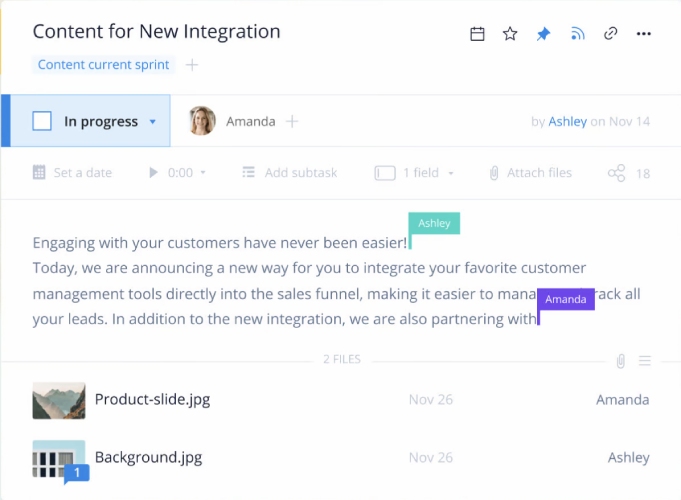
Wrike lets you add approvals for new projects or folders before they are publicly shared. (Source: Wrike)
monday.com, on the other hand, offers a few basic collaboration features, such as whiteboard, document editing, and team member tagging. While it doesn’t support built-in chat or user groups like Wrike, monday.com has an update section where team members can keep all the conversations about a specific task within the same place.
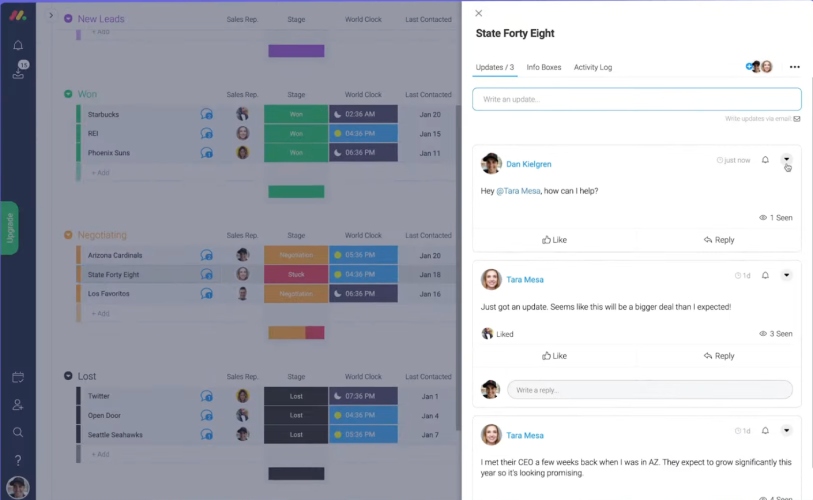
monday.com supports support team communication by allowing users to leave messages within the context of a task.
(Source: monday.com)
Best for Workflow Automation: Wrike
|
|
Wrike takes the win when it comes to workflow automation, thanks to its native Automation Engine and Work Intelligence solution. Utilize artificial intelligence (AI) to transform content, summarize long discussions, optimize resources, and identify project risk factors. You can also delegate actions with mobile voice commands and transform written documents into digital files. Wrike will also launch a few AI features soon, including work assistant and smart suggestions.
monday.com takes a different approach to workflow automation with its custom automation builder, a code-free automation tool. This allows users to create their automation flow or select from prepared templates that fit perfectly into their specific workflows. The process is pretty simple as monday.com will guide you through the steps from selecting the trigger, condition, and appropriate action.
Best for Ease of Use: monday.com
|
|
monday.com earned its reputation for its incredibly intuitive interface. It uses various visual elements like columns, colors, shapes, and graphs and has a drag-and-drop functionality for a more customizable workflow. In its recent update, monday.com introduces a cleaner and simplified look to dedicate more space to the project dashboard.
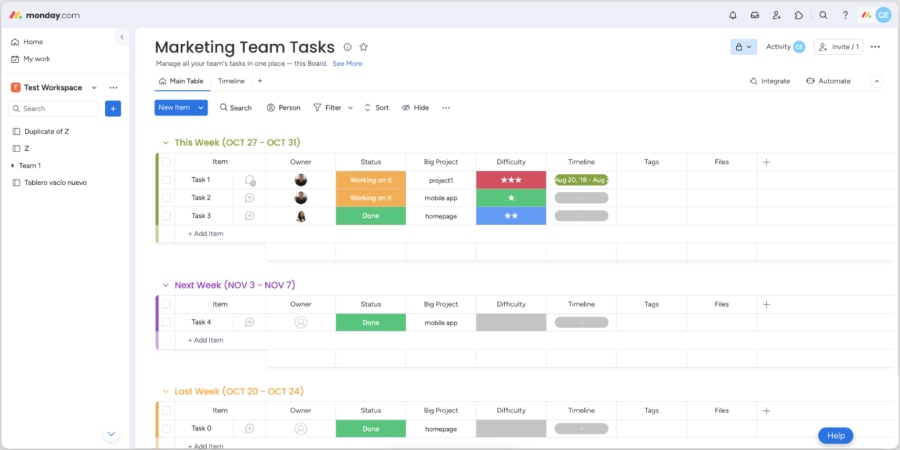
monday.com recently updated its platform to give way for a more spacious workspace. (Source: monday.com)
Unlike monday.com, Wrike emphasizes overall functionality over usability, making it slightly more complex to set up and use. The home page consists of various icons, sections, and information, which can be overwhelming for first-time users. Wrike’s building blocks consist of multiple levels (e.g., spaces, folders, and projects), which require user familiarization and onboarding to fully utilize its platform.
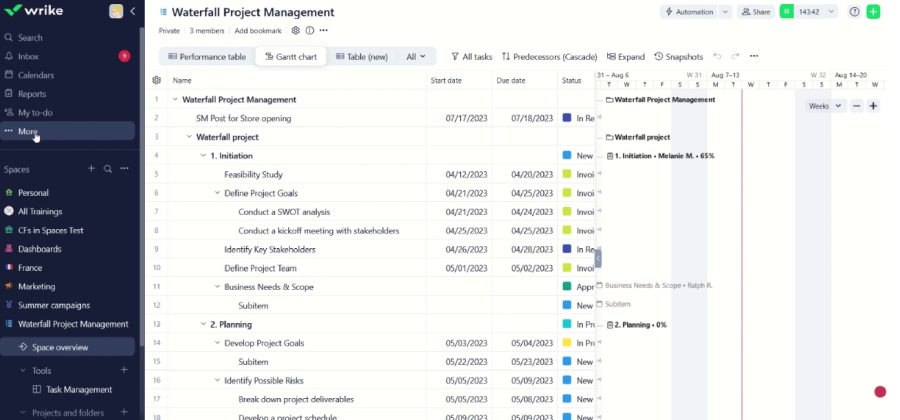
Wrike provides a central hub to easily navigate your workspaces. (Source: Wrike)
Best for Integrations: Wrike
|
|
With over 400 third-party integrations, Wrike edges out monday.com in this category. The free plan allows integrations with cloud storage platforms (e.g., Dropbox, OneDrive, and Google Drive), while the second tier Team plan includes access to productivity apps and tools.
If you’re subscribed to the Business or higher-tiered plans, you can purchase the Wrike Integrate add-on to connect Wrike to as many apps as you need. You can also add custom automation to Wrike and manage multi-app and cross-functional workflows.
monday.com has up to 200 app integrations, which you can access starting with the Standard plan. However, the use of integrations comes with a specified number of actions that renew every month. For example, you get 250 actions with the Standard plan and 25,000 actions with the Pro plan.
How We Evaluated Wrike vs monday.com
In comparing monday.com vs Wrike, we took a closer look at both providers to see what makes them the best in the market. We analyzed their strengths and weaknesses using six categories: pricing, task management, team collaboration, workflow automation, ease of use, and integrations. We also considered many factors to compare the two in detail. Here’s a complete breakdown of these factors:
- Pricing: We compared each provider’s monthly per-user pricing as well as the features that unlock at each tier, including the free plan. We checked the availability of a free trial and annual billing discounts.
- General features: We looked at capabilities essential to project management software, such as task management, time tracking, automation, and integrations. We also checked which provider has more security capabilities and better customer support coverage.
- Ease of use: We tested each platform to determine how easy it is to assign tasks, customize dashboards, and track project progress. In addition, we evaluated each provider based on ease of setup and the availability of onboarding resources.
- Expert score: We analyzed each product’s overall value by looking at the feature set and total costs. We examined user reviews to determine the popularity of both providers while considering our expert experiences.
Frequently Asked Questions (FAQs)
Yes. monday.com has its own Gantt chart, called the “timeline view.” It follows the Gantt chart layout, which offers a visual representation of the duration and deadlines of ongoing projects. Upgrading to the Standard plan is required to unlock this feature.
Unlike most competitors, Wrike has a more comprehensive feature set for workflow automation and project risk management. It uses AI to predict project delays and minimize revenue loss. While most providers limit integrations to less than 200 apps, Wrike supports over 400 third-party software.
The key difference between monday.com vs Wrike lies in its usability and customization. Wrike and other similar platforms rely heavily on hierarchy when organizing projects, tasks, and folders. monday.com uses a completely visual interface that utilizes colors and columns to enable users to interpret boards without having to read anything.
Bottom Line
Our monday.com vs Wrike match-up ended with a tie result, as both providers make excellent project management solutions depending on a specific use case. Wrike’s robust integrations, collaboration features, and powerful workflow automation are ideal for cross-functional teams involved in multiple, complex projects. monday.com, on the other hand, is an excellent choice for teams new to project management and prioritize ease of use over functionalities.
Sign up for their free plans to get a better feel of their platform before purchasing any paid plan.